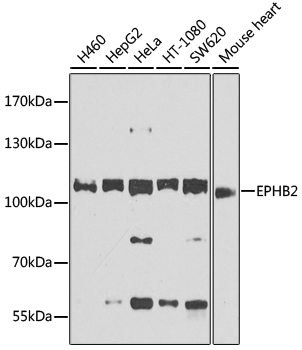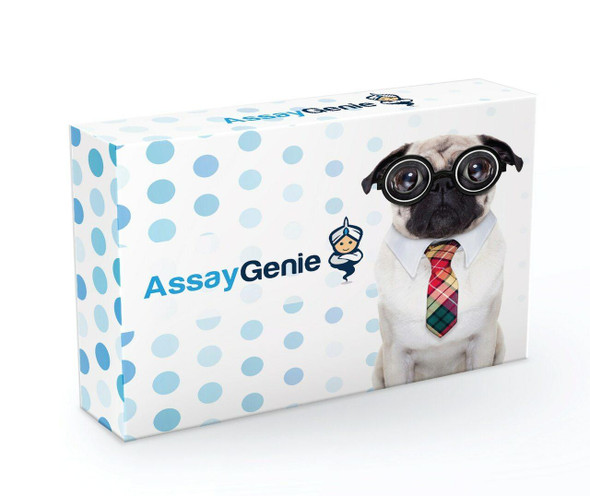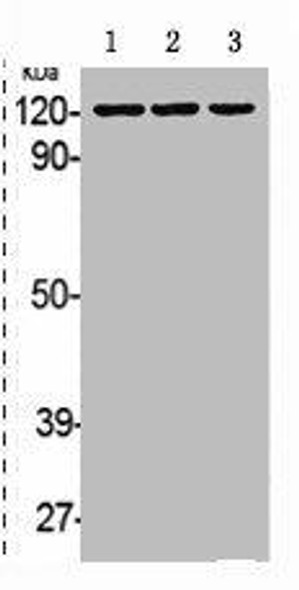Neuroscience
Anti-EPHB2 Antibody (CAB9813)
- SKU:
- CAB9813
- Product Type:
- Antibody
- Applications:
- WB
- Reactivity:
- Human
- Reactivity:
- Mouse
- Host Species:
- Rabbit
- Isotype:
- IgG
- Research Area:
- Neuroscience
Description
| Antibody Name: | Anti-EPHB2 Antibody |
| Antibody SKU: | CAB9813 |
| Antibody Size: | 20uL, 50uL, 100uL |
| Application: | WB |
| Reactivity: | Human, Mouse |
| Host Species: | Rabbit |
| Immunogen: | Recombinant fusion protein containing a sequence corresponding to amino acids 250-540 of human EPHB2 (NP_059145.2). |
| Application: | WB |
| Recommended Dilution: | WB 1:500 - 1:2000 |
| Reactivity: | Human, Mouse |
| Positive Samples: | NCI-H460, HepG2, HeLa, HT-1080, SW620, Mouse brain, Mouse heart |
| Immunogen: | Recombinant fusion protein containing a sequence corresponding to amino acids 250-540 of human EPHB2 (NP_059145.2). |
| Purification Method: | Affinity purification |
| Storage Buffer: | Store at -20'C. Avoid freeze / thaw cycles. Buffer: PBS with 0.02% sodium azide, 50% glycerol, pH7.3. |
| Isotype: | IgG |
| Sequence: | PIGR CMCK AGFE AVEN GTVC RGCP SGTF KANQ GDEA CTHC PINS RTTS EGAT NCVC RNGY YRAD LDPL DMPC TTIP SAPQ AVIS SVNE TSLM LEWT PPRD SGGR EDLV YNII CKSC GSGR GACT RCGD NVQY APRQ LGLT EPRI YISD LLAH TQYT FEIQ AVNG VTDQ SPFS PQFA SVNI TTNQ AAPS AVSI MHQV SRTV DSIT LSWS QPDQ PNGV ILDY ELQY YEKE LSEY NATA IKSP TNTV TVQG LKAG AIYV FQVR ARTV AGYG RYSG KMYF QTMT EAEY QTSI QEK |
| Gene ID: | 2048 |
| Uniprot: | P29323 |
| Cellular Location: | Cell membrane, Cell projection, Single-pass type I membrane protein, axon, dendrite |
| Calculated MW: | 109kDa/110kDa/117kDa |
| Observed MW: | 117kDa |
| Synonyms: | EPHB2, CAPB, DRT, EK5, EPHT3, ERK, Hek5, PCBC, Tyro5 |
| Background: | This gene encodes a member of the Eph receptor family of receptor tyrosine kinase transmembrane glycoproteins. These receptors are composed of an N-terminal glycosylated ligand-binding domain, a transmembrane region and an intracellular kinase domain. They bind ligands called ephrins and are involved in diverse cellular processes including motility, division, and differentiation. A distinguishing characteristic of Eph-ephrin signaling is that both receptors and ligands are competent to transduce a signaling cascade, resulting in bidirectional signaling. This protein belongs to a subgroup of the Eph receptors called EphB. Proteins of this subgroup are distinguished from other members of the family by sequence homology and preferential binding affinity for membrane-bound ephrin-B ligands. Allelic variants are associated with prostate and brain cancer susceptibility. Alternative splicing results in multiple transcript variants. |
| UniProt Protein Function: | EphB2: a receptor tyrosine kinase of the Eph family. A receptor for ephrin-B family members. Activated EphB2 recruits RasGAP, down-regulating the Ras-Erk signaling axis and neurite retraction. The Eph receptor tyrosine kinase family, the largest in the tyrosine kinase group, has fourteen members. They bind membrane-anchored ligands, ephrins, at sites of cell-cell contact, regulating the repulsion and adhesion of cells that underlie the establishment, maintenance, and remodeling of patterns of cellular organization. Eph signals are particularly important in regulating cell adhesion and cell migration during development, axon guidance, homeostasis and disease. EphA receptors bind to GPI-anchored ephrin-A ligands, while EphB receptors bind to ephrin-B proteins that have a transmembrane and cytoplasmic domain. Interactions between EphB receptor kinases and ephrin-B proteins transduce signals bidirectionally, signaling to both interacting cell types. Eph receptors and ephrins also regulate the adhesion of endothelial cells and are required for the remodeling of blood vessels. The ligand-activated form of EphB2 interacts with multiple proteins, including GTPase-activating protein (RASGAP) through its SH2 domain. Point mutations seen in prostate cancer. Overexpressed and required for migration of glioblastoma. Overexpressed and correlated with poor survival in breast cancer. Overexpression and loss of heterozygosity seen in colorectal cancers. Target for immunoconjugate drug therapy.Three splice-variant isoforms have been described. |
| UniProt Protein Details: | Protein type:Tumor suppressor; Protein kinase, TK; Protein kinase, tyrosine (receptor); Kinase, protein; Membrane protein, integral; EC 2.7.10.1; TK group; Eph family Chromosomal Location of Human Ortholog: 1p36.1-p35 Cellular Component: axon; cytosol; dendrite; extracellular region; integral to plasma membrane; plasma membrane Molecular Function:protein binding; protein-tyrosine kinase activity; transmembrane-ephrin receptor activity Biological Process: angiogenesis; axon guidance; axonal fasciculation; corpus callosum development; ephrin receptor signaling pathway; inner ear morphogenesis; nervous system development; palate development; peptidyl-tyrosine phosphorylation; phosphorylation; positive regulation of synaptogenesis; regulation of body fluid levels; urogenital system development Disease: Prostate Cancer/brain Cancer Susceptibility |
| NCBI Summary: | This gene encodes a member of the Eph receptor family of receptor tyrosine kinase transmembrane glycoproteins. These receptors are composed of an N-terminal glycosylated ligand-binding domain, a transmembrane region and an intracellular kinase domain. They bind ligands called ephrins and are involved in diverse cellular processes including motility, division, and differentiation. A distinguishing characteristic of Eph-ephrin signaling is that both receptors and ligands are competent to transduce a signaling cascade, resulting in bidirectional signaling. This protein belongs to a subgroup of the Eph receptors called EphB. Proteins of this subgroup are distinguished from other members of the family by sequence homology and preferential binding affinity for membrane-bound ephrin-B ligands. Allelic variants are associated with prostate and brain cancer susceptibility. Alternative splicing results in multiple transcript variants. [provided by RefSeq, May 2015] |
| UniProt Code: | P29323 |
| NCBI GenInfo Identifier: | 76803654 |
| NCBI Gene ID: | 2048 |
| NCBI Accession: | P29323.5 |
| UniProt Secondary Accession: | P29323,O43477, Q5T0U6, Q5T0U7, Q5T0U8, |
| UniProt Related Accession: | P29323 |
| Molecular Weight: | 110,030 Da |
| NCBI Full Name: | Ephrin type-B receptor 2 |
| NCBI Synonym Full Names: | EPH receptor B2 |
| NCBI Official Symbol: | EPHB2 |
| NCBI Official Synonym Symbols: | DRT; EK5; ERK; CAPB; Hek5; PCBC; EPHT3; Tyro5 |
| NCBI Protein Information: | ephrin type-B receptor 2 |
| UniProt Protein Name: | Ephrin type-B receptor 2 |
| UniProt Synonym Protein Names: | Developmentally-regulated Eph-related tyrosine kinase; ELK-related tyrosine kinase; EPH tyrosine kinase 3; EPH-like kinase 5; EK5; hEK5; Renal carcinoma antigen NY-REN-47; Tyrosine-protein kinase TYRO5; Tyrosine-protein kinase receptor EPH-3 |
| Protein Family: | Ephrin type-B receptor |
| UniProt Gene Name: | EPHB2 |
| UniProt Entry Name: | EPHB2_HUMAN |







